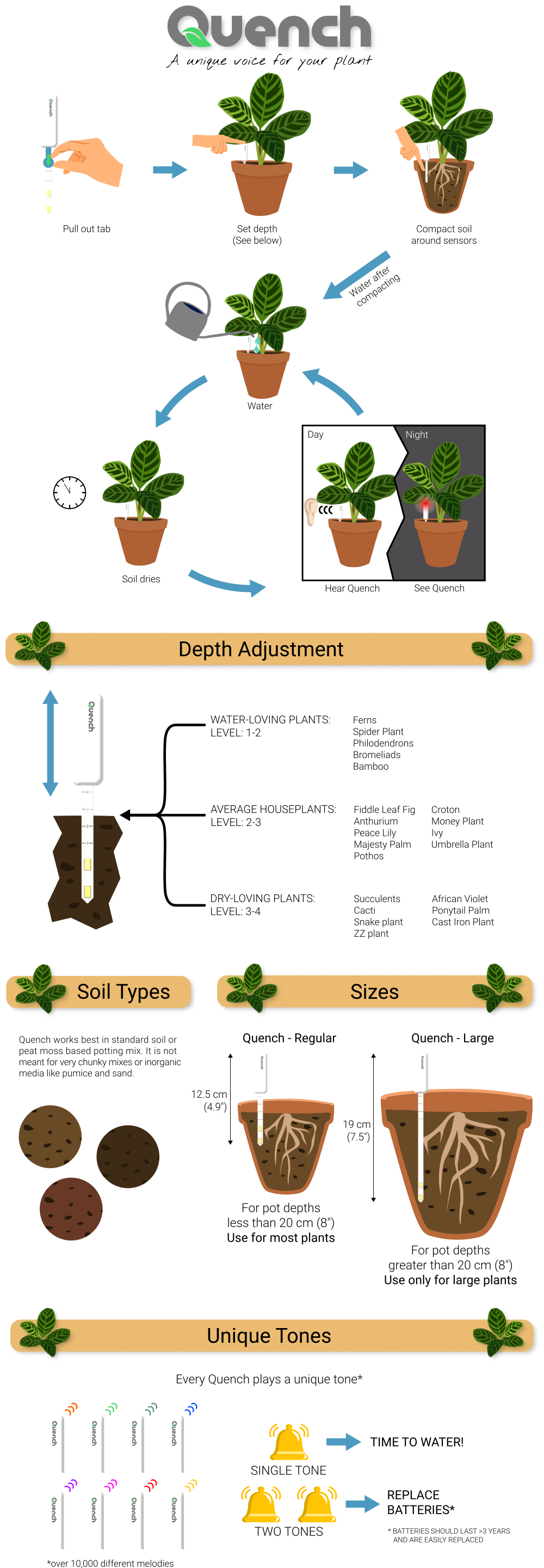How To & FAQ
FAQ
Collapsible content
How does Quench work?
Quench uses it's sensors to periodically measure the properties of the soil that it's placed in. It also measures the ambient light in order to determine if it's night or day. If the moisture content of the soil is below a threshold, Quench will produce a tone if it's daytime or blink red if it's at night.
The algorithms used help ensure that the day time and night time levels and wet and dry thresholds meet your specific environment of your plant.
Is my Quench alarming too soon?
If you think Quench is alarming too soon, here are some tips that can help:
1. The soil is not making good contact with the sensors.
- Quench works by periodically measuring the properties of the soil. The soil must make good electrical contact with the sensors in order to properly measure the soil. Anytime Quench is inserted, moved, or adjusted, make sure to use your finger to re-compact the soil around the sensors and then water. This helps remove any air gaps around the sensors and allows direct contact with the soil.
- Use your finger to compress the soil around the sensors and then water. This ensures the sensors are in direct contact with the soil.


2. Your potting mix is too chunky or not a soil/peat moss based mix.
- Quench works best in standard potting mixes. If your soil mixture it too chunky due to lots of bark, rocks, dried/live sphagnum moss or made from inorganic media like pumice or lava rock then no matter how well you try to compact the potting media around the sensors they still might not be able to make good contact.
3. Quench is not in a suitable location in the pot.
- If Quench is inserted in the middle of very dense roots where the soil has been mostly displaced, the sensors might not make good contact with the soil. Try inserting Quench such that the sensors are away from the most dense roots in your pot. If Quench is inserted so the sensors are touching the sides of the pot, they might not make good contact with the soil. As soil dries, it tends to shrink and create an air gap between the soil the pot. Try to keep Quench away from this interface and at the very least rotate Quench so the sensors face towards the middle of the pot.
4. You are not watering your plant enough.
- Be sure to water the soil thoroughly until water starts to leak out of the bottom of the pot. It also helps to water close the vicinity of Quench in order for it to stop alarming sooner.
Is my Quench alarming too late?
1. Quench thinks it’s nighttime so it’s actually blinking.
2. The batteries died.
3. Quench is too quiet.
What plants can Quench be used in?
Quench can be used with any plant that grows in standard soil or peat moss based potting mixes. Quench does not work well in very chunky mixes or inorganic media like pumice because the sensors are not able to make good contact with the substrate.
How does the 100% Guarantee Work?
Follow the Quench Troubleshooting Guide and Thriving Houseplants Gueranteed guide and if Quench still is not performing as you wish, we will offer a 100% money back guarentee.
Does Quench work outdoors?
Quench was designed to be used indoors with indoor plants. We've had many customers successfully use Quench in potted outdoor plants, but we do not recommend this.

